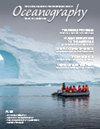PMEL Passive Acoustics Research: Quantifying the Ocean Soundscape from Whales to Wave Energy
IF 2.8
4区 地球科学
Q1 OCEANOGRAPHY
引用次数: 0
Abstract
Passive acoustic monitoring of the global ocean has increased dramatically over the last decade, providing insights into seasonal sea ice and wind/wave variability, biodiversity, geophysical hazards, and anthropogenic noise impacts. All of these phenomena are sentinels of marine ecosystem health and ocean climate change. Recognizing the utility of underwater sound, the Pacific Marine Environmental Laboratory (PMEL) formed a passive acoustic research program with the goal of quantifying deep-ocean and coastal soundscapes in support of NOAA’s mission to conserve and manage marine ecosystems. PMEL Acoustics Program researchers have built a stable of novel ocean technologies, including autonomous stationary hydrophones, mobile platforms, and near-real-time surface buoys with satellite communication capability. These passive acoustic monitoring systems have been deployed in every major ocean basin on Earth, enabling significant advancements in understanding of natural and anthropogenic sounds. This progress includes evaluation of human-made sound levels across US waters, observations of ship noise fluctuations during the COVID-19 pandemic, and evaluation of noise levels from offshore wave-energy devices. Our natural sound research includes assessment of seasonal variability in the presence of endangered cetacean species due to population recovery and/or changing ocean temperatures as well as early detection of the collapse of an Antarctic ice shelf.PMEL被动声学研究:量化从鲸鱼到波浪能量的海洋声景
在过去十年中,全球海洋的被动声学监测急剧增加,提供了对季节性海冰和风/波变化、生物多样性、地球物理危害和人为噪声影响的见解。这些现象都是海洋生态系统健康和海洋气候变化的先兆。认识到水下声音的效用,太平洋海洋环境实验室(PMEL)形成了一个被动声学研究项目,其目标是量化深海和沿海的声景,以支持NOAA保护和管理海洋生态系统的使命。PMEL声学项目的研究人员已经建立了一系列新的海洋技术,包括自主固定水听器、移动平台和具有卫星通信能力的近实时水面浮标。这些被动声学监测系统已部署在地球上的每个主要海洋盆地,使人们对自然和人为声音的理解取得了重大进展。这一进展包括评估美国水域的人为声级,观察2019冠状病毒病大流行期间船舶噪声波动,以及评估近海波浪能装置的噪声水平。我们的自然声音研究包括评估由于种群数量恢复和/或海洋温度变化而导致的濒危鲸类物种的季节性变化,以及早期发现南极冰架的崩塌。
本文章由计算机程序翻译,如有差异,请以英文原文为准。
求助全文
约1分钟内获得全文
求助全文
来源期刊

Oceanography
地学-海洋学
CiteScore
6.10
自引率
3.60%
发文量
39
审稿时长
6-12 weeks
期刊介绍:
First published in July 1988, Oceanography is the official magazine of The Oceanography Society. It contains peer-reviewed articles that chronicle all aspects of ocean science and its applications. In addition, Oceanography solicits and publishes news and information, meeting reports, hands-on laboratory exercises, career profiles, book reviews, and shorter, editor-reviewed articles that address public policy and education and how they are affected by science and technology. We encourage submission of short papers to the Breaking Waves section that describe novel approaches to multidisciplinary problems in ocean science.
 求助内容:
求助内容: 应助结果提醒方式:
应助结果提醒方式:


